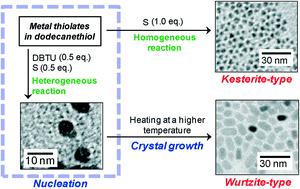Well-controlled synthesis of wurtzite-type Cu2ZnSnS4 nanoparticles using multiple sulfur sources via a two-step heating process†
Abstract
Wurtzite-type copper zinc tin sulfide (Cu2ZnSnS4) nanoparticles were prepared in dodecanethiol (DDT) solutions by reacting corresponding metal acetates with a mixture of sulfur compounds with different reactivities, elemental sulfur (S) and dibutylthiourea (DBTU), via a two-step heat treatment. Initial heating at 200 °C enabled the nucleation of metal sulfide nanoparticles composed of two crystal phases, and subsequent heat treatment at 240 °C resulted in the formation of Cu2ZnSnS4 nanoparticles with a wurtzite-type crystal structure. The resulting particles had rod shapes with a stoichiometric composition, the size and shape of which could be controlled by changing both the reaction time and the molar ratio of S and DBTU used in a sulfur precursor. In contrast, spherical Cu2ZnSnS4 nanoparticles with a kesterite-type crystal structure were produced by reaction with pure S as a precursor. The electronic energy levels of the conduction band and valence band edges were determined for wurtzite-type Cu2ZnSnS4 nanoparticles by photoelectrochemical measurement, the individual levels being comparable to those of kesterite-type ones. The light–electricity conversion efficiency varied remarkably depending on the kind of crystal structure: wurtzite-type Cu2ZnSnS4 particles exhibited an efficiency superior to that of the particles with a kesterite-type crystal structure.


 Please wait while we load your content...
Please wait while we load your content...